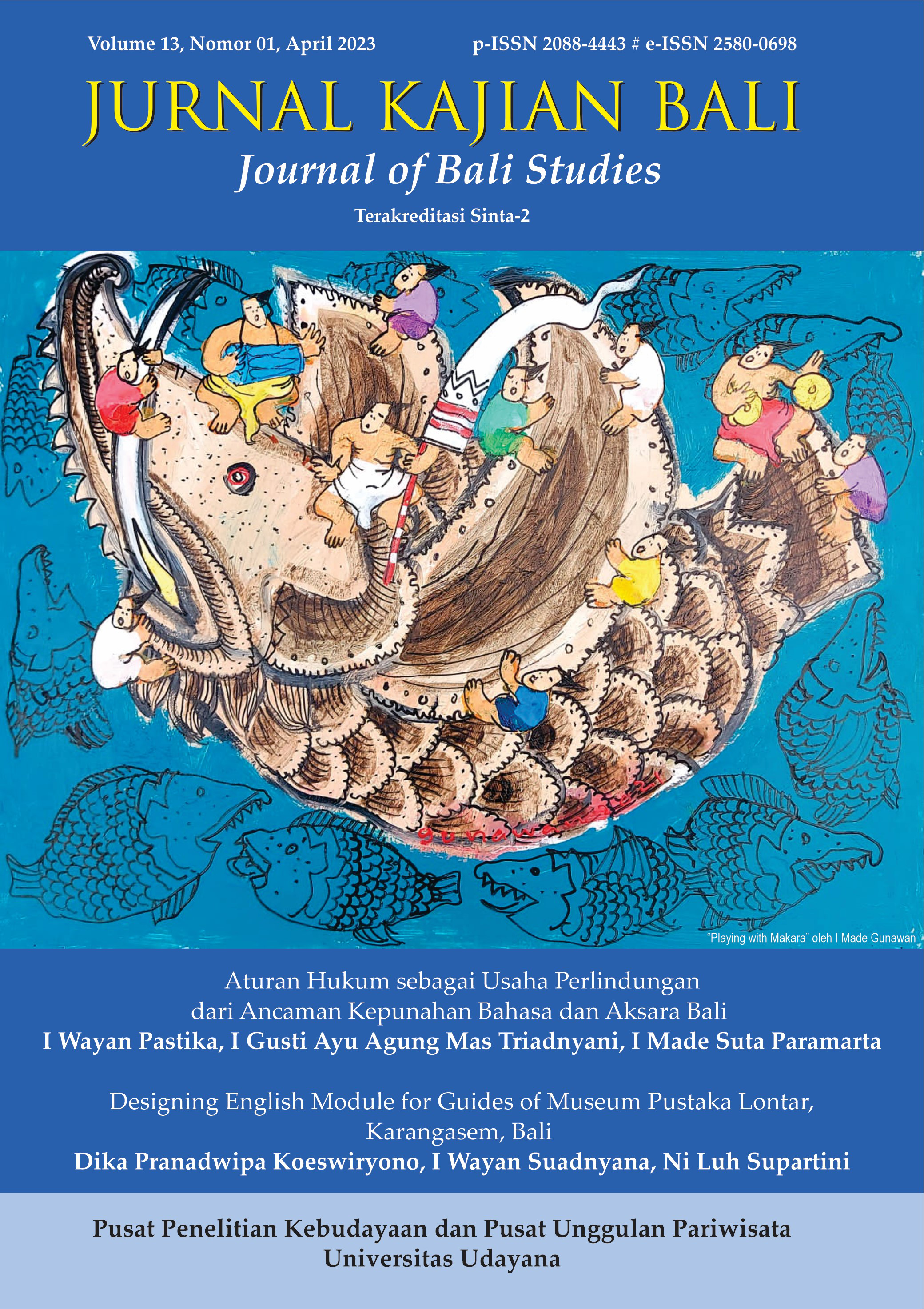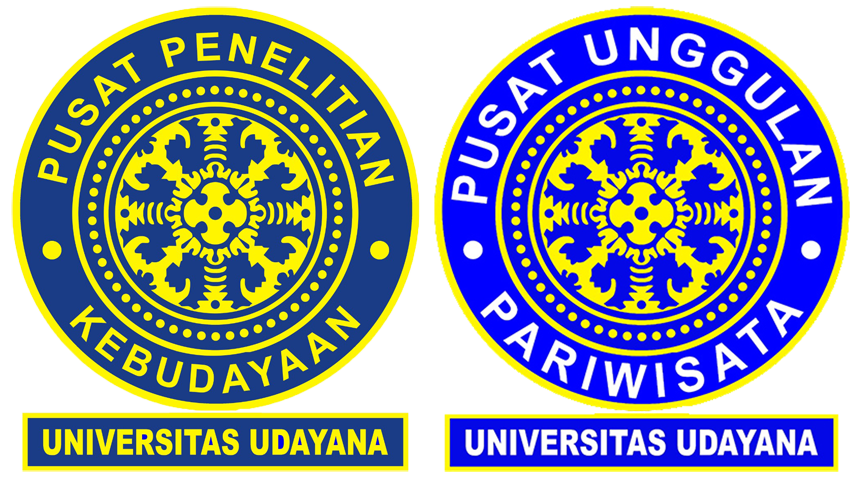Influence of Spatial Attributes on Human Behavior in Complying with COVID-19 Health Protocols in The City Park of Puputan Badung Denpasar Bali
Abstract
The study aims to determine the most effective spatial setting for the fitness spots with pandemic mitigation in the city park of Puputan Badung Denpasar Bali as well as to identify various responses of human behavior in complying with health protocols. A mixed-method strategy was utilized, where a quantitative technique was used to determine the level of compliance. A qualitative inquiry with a case study method was also used to assess the influence of spatial attributes on human behavior. The respondents were selected using accidental sampling during peak times for a week. The sport activities observed were fitness, which was available in several spots of parks. Based on human behavior theories, the fitness space equipped with COVID-19 mitigation measures has not provided optimal stimuli to the people in complying with health protocols, leading to low compliance levels. The results of this study can be used as a reference to evaluate the effectiveness of implementing pandemic mitigation in the city park of Puputan Badung and other city parks with similar characteristics from an architectural perspective.
Downloads
References
Andrusaityte, S., Grazuleviciene, R., Dedele, A., and Balseviciene B. (2020). The effect of residential greenness and city park visiting habits on preschool Children’s mental and general health in Lithuania: A cross-sectional study International Journal of Hygiene and Environmental Health, vol. 223, pp 142-150. https://www.sciencedirect.com/science/article/abs/pii/S1438463919302718
Anendawaty, R. S., Adityas, P., Dwi, A. S., Nur, R. A., Daisy, R. Ray, M. S., and Priambudi, T. P. (2017). Perencanaan taman kota sebagai salah satu atribut kota hijau di Kecamatan Gedebage, Bandung. Vitruvian: Jurnal Arsitektur, Bangunan, dan Lingkungan, vol. 6, pp 85-90.
Aggita, R. P., Eppy, Y., and Boby, R. (2019). Pembentukan ruang aktivitas sosial pada ruang terbuka publik Taman Menteri Supeno. Jurnal Planologi, vol. 14, pp 135-149. http://lppm-unissula.com/jurnal.unissula.ac.id/index.php/psa/article/view/3870
Ayoko, O. B., Ashkanasy, N. M. (editors). (2019). Organizational behaviour and the physical environment. Routledge.
Bandura, A. (2001). Social cognitive theory of mass communication. Media Psychology, vol. 3, pp 265-299.
Banai, R. (2020). Pandemic and the planning of resilient cities and regions. Cities, vol. 106, p 102929.
Bunakov, O. A., Eidelman, B. M., and Fakhrutdinova, L. R. (2019). Creation and use of city parks for tourism and the recreation .Academic Journal of Interdisciplinary Studies, vol. 8, pp 21-26. https://www.richtmann.org/journal/index.php/ajis/article/view/10604
Chen, Z., King, B., and Suntikul, W. (2019). Festivalscapes and the visitor experience: an application of the stimulus organism response approach. International Journal of Tourism Research, vol. 21, pp. 758-71. https://onlinelibrary.wiley.com/doi/abs/10.1002/jtr.2302
Cheng, Y., Zhang, J., Wei, W., and Zhao, B. (2021). Effects of urban parks on residents’ expressed happiness before and during the COVID-19 pandemic. Landscape and Urban Planning, vol. 212, p 104118.
Denzin, N. K. and Lincoln, Y. S, (editors). (2008). Strategies of qualitative inquiry. Sage Publication.
Delice, A. (2010). The sampling issues in quantitative research. Educational Sciences: Theory and Practice, vol, 10, p. 18. https://eric.ed.gov/?id=EJ919871
Devi, B., Khandelwal, B., and Das, M. (2017) Application of Bandura’s social cognitive theory in the technology enhanced, blended learning environment. International Journal of Applied Research, vol. 3, p 721-724.
Doubleday, A., Choe, Y., Busch, I. T., Miles, S., and Errett, N. A. (2021). How did outdoor biking and walking change during COVID-19? A case study of three US cities. Plos One, vol. 20, https://journals.plos.org/plosone/article?id=10.1371/journal.pone.0245514
Groat, L. N. and Wang, D. (2013). Architectural research methods. John Wiley & Sons.
Jacoby, J. (2002). Stimulus‐organism‐response reconsidered: an evolutionary step in modeling (consumer) behavior. Journal of consumer psychology, vol. 12, pp 51-57.
Jenny, R., Aspinall, P. A., and Thompson, C. W. (2016) Understanding relationships between health, ethnicity, place and the role of urban green space in deprived urban communities. International. Journal of Environmental Research and Public Health, vol. 13. https://www.mdpi.com/1660-4601/13/7/681
Kementerian Kesehatan RI. (2020). Keputusan Menteri Kesehatan Nomor HK.01.07/MENKES/382/2020 tentang Protokol kesehatan bagi masyarakat di tempat dan fasilitas umum
Laato, S., Islam, A. K. M. N, Faroog, A., and Dhir, A. (2020) Unusual purchasing behavior during the early stages of the COVID-19 pandemic: The stimulus-organism-response approach. Journal of Retailing and Consumer Services, vol. 57, p 102224.
Lai, K. Y., Webster, C., Kumari, S. and Sarkar, C. (2020). The nature of cities and the Covid-19 pandemic. Current Opinion in Environmental Sustainability, vol. 46, pp. 27-31. https://www.sciencedirect.com/science/article/pii/S1877343520300622
Larson, L. R., Jennings, V., and Cloutier, S. A. (2016). Public parks and wellbeing in urban areas of the United States. PLoS one, vol. 11, p e0153211.
Lopes, G. T., Urbano, M. R., Hino, A. A., and Kanashiro, M. (2021). Evaluating park usage through public health protocols: a comparative study. Ambiente Construído, vol. 21, pp. 225-41, https://doi.org/10.1590/s1678-86212021000200523
Luborsky, M. R., and Rubinstein, R. L. (1995). Sampling in qualitative research: rationale, issues, and methods. Research on aging, vol. 17, pp. 89-113.
Nabavi, R. T. (2012). Bandura’s social learning theory and social cognitive learning theory. University of Science and Culture.
Ng, C. F. (2016). Behavioral mapping and tracking. Research methods for environmental psychology, pp 29-51.
McQuail, D. (2010). McQuail’s mass communication theory. SAGE Publications Ltd.
Olufemi, T. D. (2012). Theories of attitudes. Psychology of Attitudes, pp. 61-78.
Porajouw, E. F. R. J., Poluan F. M. (2017) Efektivitas ruang terbuka publik di Kota Tomohon. Spasial: Perencanaan Wilayah dan Kota, vol. 4, pp. 136-148. https://ejournal.unsrat.ac.id/index.php/spasial/article/view/15546/0
Plunz, R. A., Zhou, Y., Carrasco, V. M. I., Mckeown, K., Yu, T., Uguccioni, L. and Sutto M. P. (2019) Twitter sentiment in New York City parks as measure of well-being. Landscape and Urban Planning, vol, 189, pp. 235-246. https://doi.org/10.1016/j.landurbplan.2019.04.024
Ramagole, D. A., van Rensburg, D. C., Pillay, L., Viviers, P., Zondi, P. and Patricios, J. (2020 )Implications of COVID-19 for resumption of sport in South Africa: A South African Sports Medicine Association (SASMA) position statement. South African Journal. Sports Medicine, vol. 32, pp. 1-6 http://www.scielo.org.za/scielo.php?script=sci_arttext&pid=S1015-51632020000100016
Rita, G. (2017). Taman kota sebagai modal sosial dan interaksi masyarakat Kota Bandung. Jurnal Signal, vol. 5, pp. 1-11. http://jurnal.ugj.ac.id/index.php/Signal/article/view/887
Sang, A. O., Knez, I., Gunnarsson, B. and Hedblom, M. (2016). The effects of naturalness, gender, and age on how urban green space is perceived and used. Urban Forestry and Urban Greening, vol. 18, pp. 268–276. https://doi.org/10.1016/j.ufug.2016.06.008
Sherer, P. M. (2003). Why America Needs More City Parks and Open Space. The Trust for Public Land.
Smiley, K. T., Sharma, T., Steinberg, A., Hodges-Copple, S., Jacobson, E. and Matveeva, L. (2016). More inclusive parks planning: park quality and preferences for park access and amenities. Environment Justice, vol. 9, pp. 1-7. https://www.liebertpub.com/doi/abs/10.1089/env.2015.0030
Suardana, I W., Kristianto, Y. (2022). Atribut Destinasi, Persepsi Risiko, Kepercayaan, dan Niat Berkunjung Wisatawan ke Pulau Nusa Penida Klungkung Bali pada Masa Pandemi Covid-19. Jurnal Kajian Bali (Journal of Bali Studies), vol. 12, pp 471-491. https://ojs.unud.ac.id/index.php/kajianbali/article/view/87539
Sung, H., Kim, W-R; Oh, J., Lee, S., Lee, P. S.-H. (2022). Are All Urban Parks Robust to the COVID-19 Pandemic? Focusing on Type, Functionality, and Accessibility. International Journal of Environmental Research and Public Health, vol. 19, p 6062.
Sutopo. (1996). Metodologi Penelitian Kualitatif. Universitas Sebelas Maret Press.
Stake, R. E. (2010). Qualitative research: studying how things work. The Guilford Press.
Venter, Z. S., Barton, D. N., Gundersen, V., Figari, H. and Nowell, M. (2020 ).Urban nature in a time of crisis: recreational use of green space increases during the COVID-19 outbreak in Oslo. Norway Environ. Res. Lett. Vol. 15. https://iopscience.iop.org/article/10.1088/1748-9326/abb396/meta
Wolch, J. R., Byrne, J., and Newell, J. P. (2014). Urban green space, public health, and environmental justice: The challenge of making cities ‘just green enough’. Landscape and urban planning, vol. 125, pp 234-244.
Weisman, G. D. (1981). Modelling environment-behavior system: brief note, man-environment relation. The Pennsylvania State University.
Xie, J., Luo, S., Furuya, K., and Sun, D. (2020). Urban parks as green buffers during the COVID-19 pandemic. Sustainability, vol. 12, p 6751.
Yin, R. K. (2003). Designing case studies Qualitative Research Methods, vol. 5, pp. 359-86.
Yu, J., Yokota, T., Itami, E. and Yang, J. (2021). Correlations between spatial attributes and visitor stay in Chinese gardens: a case study of the Ningbo Tianyige Museum Gardens. Urban Science, vol. 5, p. 74. https://www.mdpi.com/2413-8851/5/4/74
Zeisel, J. (1984). Inquiry by design: tools for environment-behavior research. Cambridge University Press.

This work is licensed under a Creative Commons Attribution 4.0 International License.



















